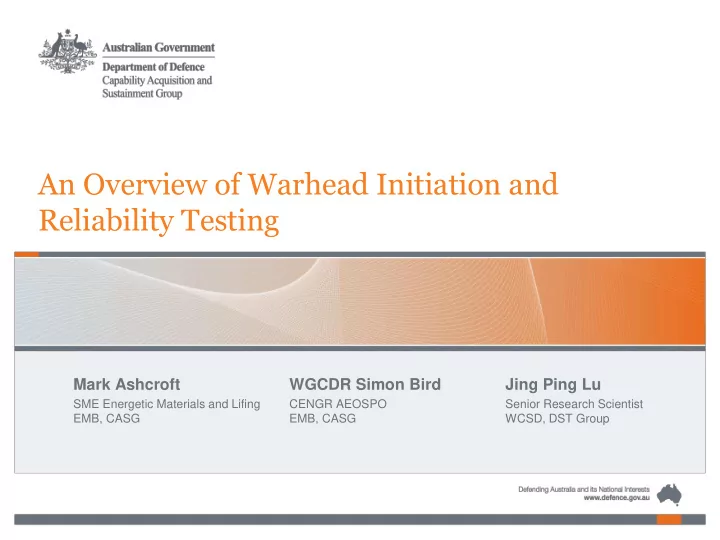

An Overview of Warhead Initiation and Reliability Testing Mark Ashcroft WGCDR Simon Bird Jing Ping Lu SME Energetic Materials and Lifing CENGR AEOSPO Senior Research Scientist EMB, CASG EMB, CASG WCSD, DST Group
Overview 1. Background 2. Energetic material properties 3. Challenges 4. Solutions 5. Outcomes
Background The aim is to deliver a presentation that meets the primary objectives of PARARI 2019. • Safe Explosive Ordnance for the Warfighter Through Innovative Technology & Culture. – Safer EO with an improved IM response – Innovative sub-scale testing and modelling – Collaborative culture delivering effective solutions • AFHQ • CASG • Australian Munitions (Thales) • DST Group • JPEU • DOS • Energetic Materials Science to EO safety – Explosive manufacture – Material characterisation – Modelling Highlight engineering challenges that otherwise go unnoticed if all goes to plan.
Background Defence initiated work with Australian Munitions (Thales) to develop the indigenous manufacture of modernised aircraft bombs. • Improvements in aircraft bomb warhead effectiveness • Lifecycle tolerance • Insensitive munition response • Supply chain surety Existing infrastructure and previous experience have supported this venture. Uncertainties existed due to the characteristics of certain ingredients sourced in Australia for explosive formulation AX2001. • Properties of Australian produced Grade A RDX – Leads to an explosive fill with significantly lower shock sensitivity compared to PBXs with RDX Type II. • AX2001 has significant advantages wrt susceptibility to hazard stimuli. • Research has been conducted to ensure the fill remains sufficiently sensitive to initiation from in-service fuzes.
Energetic Material Properties In order to transition a new explosive fill into service the performance and safety characteristics are required IAW STANAG 4170. Testing was conducted by DST Group: • Performance – Detonation pressure – VOD • Safety characteristics – Small scale hazard tests – Shock sensitivity – large scale gap test (LSGT) Complimented by Australian Munitions (Thales) testing: • Material properties – hardness, tensile and density • Vacuum stability The results informed the Energetic Material Qualification (EMQ) to support approval for introduction into service.
Energetic Material Properties A focus on the LSGT conducted at DST Group.
Energetic Material Properties PBX formulations produced with different grades of RDX. • Work presented by DST Group at PARARI 2011 • Table indicates the difference in shock sensitivity test results between formulations made with RDX Type I and RDX Type II • Australian Munitions (Thales) Grade A RDX comparable to reduced sensitivity RDX
Engineering Challenges – Part 1 Bombs are in production with an AX2001 explosive fill. • The main fill explosive is significantly different from PBXN-109 in that AX2001 utilises RDX-Type I – Known to be approx. 40% more insensitive A body of work was required to provide assurance that differences in the main fill do not present a initiation issue.
Fuze Initiation and Reliability Trial To evaluate the likelihood of detonation using current fuzing a trial was conducted by DST Group and JPEU. • Generic test units were produced and used to determine Fuze Initiation and Reliability. • Fuze initiated with a DST Group custom electronic switch. • Initiation confirmed with high speed video and witness plate examination.
Engineering Challenges – Part 2 A move to higher resolution x-ray equipment highlighted a gap between the Fuze Liner Assembly and the AX2001 fill. • There was a need to assess what size of gap is tolerable from a Fuze reliability perspective
Radiography JPEU radiograph of the aft end.
Radiography JPEU radiograph of the aft end – close-up. • Separation identified where no gap can be tolerated IAW Design Spec.
Functional Trial Trial Setup (JPEU Port Wakefield) to determine functional performance.
Functional Trial Initiation of main explosive fill confirmed. • Video • Fragment analysis
Modelling The need remained to more effectively study warhead initiation reliability. • DST Group and CASG collectively developed a modelling program – The aim was to access tolerable gap sizes between the fuze liner assembly and the main explosive fill. • The modelling program was designed to: – Minimise experimental test assets – Provide increased confidence of initiation – Indicate acceptance level of a tolerable gap size – Ensure efficient delivery of safe and effective EO – Prevent delay in production
Modelling The latest modelling work conducted by DST Group will be the focus of the next presentation. A CASG perspective… • CASG were able to utilise and leverage over a decades worth of knowledge and investment to deliver a efficient solution. • Modelling program achieved objectives – A significant safety factor applied – Small gaps seen are tolerable
Outcome Successful outcomes of the journey: • EMQ – approved • Initiation and reliability – assured with objective quality evidence • A new manufacturing resource for Australia • Pan Defence approach to provide engineering solutions • Delivering enhanced capability to Defence Next steps • Progress with confidence the safe and suitable for service assessment
Questions
Recommend
More recommend